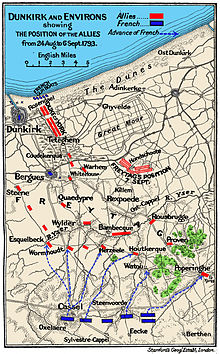Battle of Hondschoote
| date | September 8, 1793 |
|---|---|
| place | Hondschoote |
| output | French victory |
| Parties to the conflict | |
|---|---|
| Commander | |
| Troop strength | |
| 40,000 | 18,000 |
| losses | |
|
Unknown |
Unknown |
First Coalition War (1792–1797)
Verdun - Thionville - Valmy - Lille - Mainz (1792) - Jemappes - Namur - Neerektiven - Mainz (1793) - Famars - Valenciennes (1793) - Arlon (1793) - Hondschoote - Meribel - Avesnes-le-Sec - Pirmasens - Toulon - Fontenay-le-Comte - Cholet - Lucon - Trouillas - Menin - Wattignies - Biesingen - Kaiserslautern (1793) - First Battle of Weissenburg (1793) - Second Battle of Weissenburg (1793) - Boulou - Tourcoing - Tournay - 13th Prairial - Fleurus - Vosges - Aldenhoven - San-Lorenzo de la Muga - Genoa - Hyeres - Handschuhsheim - Mainz (1795) - Loano - Montenotte - Millesimo - Dego - Mondovi - Lodi - Borghetto - Castiglione - Mantua - Siegburg - Altenkirchen - Wetzlar - Kircheib - Kehl - Kalteiche - Malsch - Neresheim - Deining - Amberg - Würzburg - Rovereto - Bassano - Limburg - Biberach I - Emmendingen - Schliengen - Arcole - Fall von Kehl - Rivoli (1797) - St. Vincent - Diersheim - Santa Cruz - Neuwied - Camperduin
The Battle of Hondschoote was a clash between the troops of the French Republic and units of the Allies during the First Coalition War on September 8, 1793. Following the victory of the French Northern Army under General Houchard , the Duke of York had to give up the siege of Dunkirk .
background
At the beginning of 1792 the first grand coalition against revolutionary France was formed. As a result, the French troops initially had to retreat. Domestically, this contributed to the radicalization and the establishment of Jacobin rule . Militarily, this resulted in a revolution in French warfare, including the creation of the Levée en masse .
After the Allied army in Flanders under Prince Josias of Saxe-Coburg-Saalfeld had successfully besieged both Condé-sur-l'Escaut and Valenciennes in the summer of 1793 , a corps of 35,000 men under the Duke of York was deployed to the siege of Dunkirk . This began at the end of August with the siege of the fortress defended by around 8,000 French under Joseph Souham , whose possession had been claimed by the British in earlier negotiations with the Allies.
course
Against this background, the war turned in autumn 1793. On September 8th, the armies met in a battle near Hondschoote in the French part of Flanders (Département Nord-Pas-de-Calais ). The French army was under the leadership of General Jean-Nicolas Houchard , Guillaume-Marie-Anne Brune and Jean Baptist Bernadotte - who later became Charles XIV John of Sweden - also participated. The Allied troops consisted mainly of British, Hanoverians and Austrians . They were commanded by the Hanoverian Marshal Wilhelm von Freytag , who led the left wing of the Allies and was supposed to cover York's siege troops. The Austrian units were under the command of Joseph Alvinczy von Berberek . The French army came on September 6th from the direction of Steenvorde and Bailleul and pushed the Allied troops back to Hondschoote. This position was captured on September 8th.
consequences
As a result of the defeat at Hondschoote, the Duke of York had to give up the siege of Dunkirk . After the defeat of the Austrians in the Battle of Wattignies on October 14th and 16th, 1793, all intervention forces had to withdraw from northern France. The British troops that landed in Toulon could no longer hold out either.
Others
Scharnhorst distinguished himself for the first time in this battle . As titular captain, he led only a single mounted battery , but on his own initiative he took command of troops fleeing panic and enabled an orderly retreat in cold blood by firing at an opposing défilé . At the next post of retreat, the city of Menin , the entire artillery, including the fortress guns, was under his control. He also managed to rescue the temporarily imprisoned Prince Adolph Friedrich , the future Duke of Cambridge, from his predicament.
The painter Eugène Louis Lami made a painting of this battle in the 19th century.
Web links
- jop-kriegskunst.de ( Memento from August 18, 2004 in the web archive archive.today ) - Page about the coalition wars
- almg.free.fr - General Houchard website with a description of the battle (French)
- La Bataille d'Hondschoote ( Memento from May 6, 2007 in the Internet Archive ) - The Battle of Hondschoote (French)


